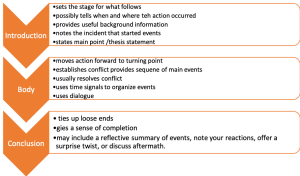11 The Structure of a Narrative Essay
Major narrative events are most often conveyed in chronological order, the order in which events unfold from first to last. Stories typically have a beginning, a middle, and an end, and these events are typically organized by time. Certain transitional words and phrases aid in keeping the reader oriented in the sequencing of a story. Some of these phrases are listed in Table 4.1″Transition Words and Phrases for Expressing Time”.
Table 4.1 Transition Words and Phrases for Expressing Time
| after/afterward | as soon as | at last | before |
| currently | during | eventually | meanwhile |
| next | now | since | soon |
| finally | later | still | then |
| until | when/whenever | while | first, second, third |
The following are basic components of a narrative:
- Plot. The events as they unfold in sequence.
- Characters. The people who inhabit the story and move it forward. Typically, there are minor characters and main characters. The minor characters generally play supporting roles to the main character, or the protagonist.
- Conflict. The primary problem or obstacle that unfolds in the plot that the protagonist must solve or overcome by the end of the narrative. The way in which the protagonist resolves the conflict of the plot results in the theme of the narrative.
- Theme. The ultimate message the narrative is trying to express; it can be either explicit or implicit.
Following are suggestions for organizing the narrative essay:

Writing at Work
When interviewing candidates for jobs, employers often ask about conflicts or problems a potential employee has had to overcome. They are asking for a compelling personal narrative. To prepare for this question in a job interview, write out a scenario using the narrative mode structure. This will allow you to troubleshoot rough spots, as well as better understand your own personal history. Both processes will make your story better and your self-presentation better, too.
 Writing Exercise
Writing Exercise
Take your freewriting exercise from the last section and start crafting it chronologically into a rough plot summary. Be sure to use the time transition words and phrases listed in Table 4.1 “Transition Words and Phrases for Expressing Time” to sequence the events.

